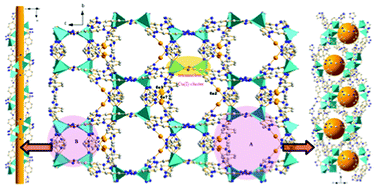Assembly of copper–tetrazole frameworks with role-changeable Keggin clusters: syntheses, structures, solvent-dependent luminescence and electrochemistry properties†
Abstract
Two new Keggin-based hybrids with polynuclear Cu(I) clusters, formulated as [Cu4(HL)4(SiW12O40)]·6H2O (1) and [Cu6.5(HL)2(L)4(H2O)(H1.5SiW12O40)]·3H2O (2) (HL = 5-(4-imidazol-1-ylphenyl)-2H-tetrazole), have been hydrothermally synthesized and characterized by routine techniques. In 1, Keggin polyanions [SiW12O40]4− (SiW12) link adjacent [Cu4(HL)4]n chains to generate a 2D network. In 2, a cationic (2,3,11)-connected 3D framework, {Cu6.5(HL)2(L)4(H2O)}2.5+, is induced by SiW12 as the template. The differences in the structures of compounds 1 and 2 indicate that pH and the acid radical ions in the initial reaction system play a key role in determining the final structures. Interestingly, the


 Please wait while we load your content...
Please wait while we load your content...